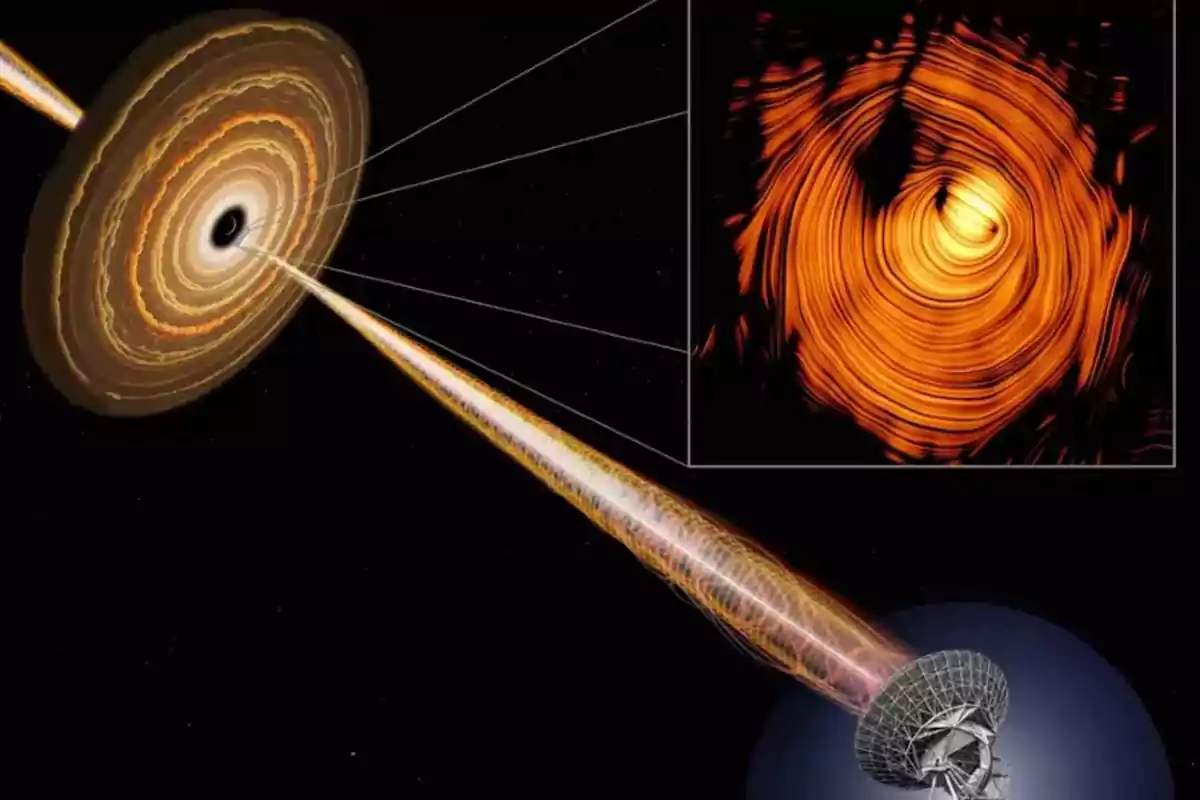
Perfect magnetic ring found in black hole jet
Astronomers reveal an almost perfect magnetic ring in the jet of a black hole, key to the production of gamma rays and neutrinos.
Astronomers have peered straight down the throat of a distant black hole’s jet and found a near perfect, ring-shaped magnetic field evidence of a hidden engine that supercharges particles to extreme energies.
The target, blazar PKS 1424+240, looks slow in radio images but blazes in high-energy gamma rays and neutrinos; a new analysis shows its jet is aimed almost exactly at us, making it appear deceptively sluggish while dramatically boosting its brightness.
Why this discovery matters
High-energy multimessenger astronomy neutrinos are “ghost” particles that rarely interact with matter, so tracing them back to their sources has been a central challenge in multimessenger astronomy. PKS 1424+240 stands out: IceCube analyses rank it among the brightest blazar sources of high-energy neutrinos, yet past radio data suggested only modest jet speeds a long-standing contradiction known as the Doppler-factor crisis.
The new result links jet geometry and magnetic structure to the observed neutrino and gamma-ray output, tightening the case that active galaxies can accelerate not only electrons but also protons.
How VLBA exposed the jet core
Researchers stacked and aligned 42 polarization-sensitive images taken with the National Science Foundation’s Very Long Baseline Array (VLBA) from 2009 to 2025 at 15 gigahertz, effectively creating a deep, high-dynamic-range view of the blazar’s inner few light-years. The composite image reveals a clear toroidal (ring-shaped) magnetic field threading the flow, a signature of a current carrying jet and shows that we are viewing the jet from inside its cone, within less than 0.6 degrees of its axis. In this geometry, relativistic beaming boosts the observed emission by a factor of roughly 30, reconciling the jet’s “slow-looking” radio motion with its intense gamma-ray and neutrino output.
“When we reconstructed the image, it looked absolutely stunning… a near-perfect toroidal magnetic field with a jet pointing straight at us,” said Yuri Kovalev, lead author of the study at the Max Planck Institute for Radio Astronomy. Co-author Jack Livingston added that this nearly head-on view provides a “boost in brightness by 30 or more,” while projection effects make the jet appear slow.
PKS 1424+240 in context
PKS 1424+240 lies billions of light-years away and, at a redshift of 0.605, is among the most distant blazars detected in quiescent very high-energy gamma rays. The VLBA’s ten dishes, spread across the United States from Hawaii to the Virgin Islands, can resolve details as fine as about 50 microarcseconds sharp enough to pick out magnetic patterns near the jet’s base. The data comes from MOJAVE, a decades-long VLBA program that tracks brightness and polarization changes in blazar jets. The team’s stacking approach boosted sensitivity, exposing faint, persistent structures around the core that single-epoch images missed.
“This link between black-hole jets and cosmic neutrinos felt like science fiction when MOJAVE began,” said Anton Zensus, director at MPIfR and a program co-founder. “Today, our observations are making it real.”
How toroidal fields power jets
The toroidal field acts like a compressed spring, channeling and accelerating particles along the jet. Seeing the jet from inside its cone both maximizes the beaming of high-energy photons and neutrinos toward Earth and minimizes the apparent sky motion of radio features precisely the combination that puzzled astronomers for years.
The team argues that such nearly head-on jets may be a distinct, rare class of active galactic nuclei that dominate the brightest gamma-ray and neutrino samples despite their scarcity. Monte Carlo simulations suggest only a few percent of jets are aligned within a degree of our line of sight.
What astronomers will test next
The authors propose targeted searches for other “inside-the-cone” jets and coordinated campaigns that combine VLBA polarimetry, gamma-ray monitoring, and IceCube data to test whether toroidal fields and tiny viewing angles are a common recipe for neutrino production.
Broader surveys within MOJAVE could reveal how often these magnetic rings appear and whether they evolve with flares.
Limits and open questions ahead
This is a single, unusually well-aligned source. While the geometry neatly resolves the Doppler factor crisis for PKS 1424+240, the field structure and beaming levels must be confirmed across a larger sample, and models still need to pin down where and how protons are accelerated to produce neutrinos.Further observations will test whether the same physics holds in less extreme alignments.

More posts: